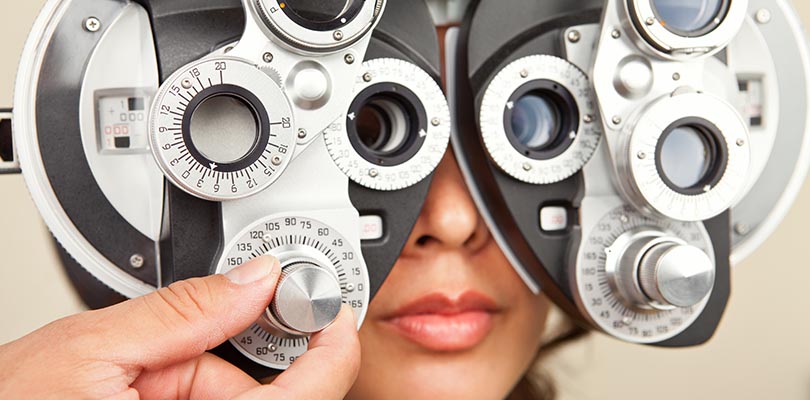Astigmatism
Astigmatism may sound like a big, scary word, but it simply means that your eye isn’t perfectly round. And, most of us have this vision condition to some degree.
A normal eye has a perfectly round shape – as light enters the eye, it bends evenly resulting in clear vision. However, with astigmatism, the eye is shaped irregularly with an imperfection in the curvature of either the cornea or lens. As a result, when light enters the eye, it doesn’t get adequately bent, resulting in only one part of an object being in focus. This may lead to blurry and/or wavy vision when looking at objects.
Astigmatism is categorized as either corneal (misshaped cornea) or lenticular (misshaped lens).
Causes of Astigmatism
Astigmatism is caused by abnormal curvature of the cornea or lens of the eye. The exact cause of abnormal curvature isn’t known; however, in many cases, you’re born with it, so there’s likely a hereditary component. That said, astigmatism isn’t always an inherited condition – sometimes trauma or injury to the eye might cause it.
You may have heard that reading in low light or watching TV too closely can trigger this condition, but this is simply a myth.
Symptoms of Astigmatism
Common symptoms of astigmatism include:
- Blurry vision
- Eye fatigue
- Eyestrain
- Headaches alongside blurring or alteration of vision across all distances
- Double vision
- Squinting
- Eye irritation
How Is It Diagnosed?
Your eye doctor can detect astigmatism through a detailed eye examination. Eye doctors use a wide array of tests during your eye examination to detect astigmatism, including:
Visual Acuity
Your eye doctor will measure your visual acuity by making you read letters on a far-off chart. The letters get gradually smaller on each line.
Visual acuity is denoted as a fraction, for instance, 20/40. The numerator is the uniform testing distance (20 feet) while the denominator is the least letter size read.
With a visual acuity of 20/40, you will have to move within 20 feet to see letters that are clearly visible at 40 feet. Experts consider 20/20 visual acuity as normal.
Retinoscopy
Your eye doctor conducts this test to approximate the degree of astigmatism you have. It involves focusing light to the eye while placing different kinds of lenses directly at the fore of the eye.
Astigmatic Dial
This astigmatic test features a chart displaying a chain of lines that form a semi-circle. These lines will be clearly visible to people with perfect vision. But for people with astigmatism, some of the lines will be more visible than others.
Keratometry
This test involves the use of a device called a keratometer to evaluate the extent of abnormal curvature of the cornea.
How Is Astigmatism Corrected and Treated?
Astigmatism is a treatable condition. There are plenty of options that people with astigmatism can use to restore clear vision. Here are a few of them:
Eyeglasses
Individuals with astigmatism usually opt for eyeglasses to enhance their vision. The glasses feature a unique cylindrical lens prescription, which offsets astigmatism. This supplies more power in certain sections of the lens.
A single-vision lens offers a clear vision for both close-up and distant objects. While a bifocal lens is prescribed for patients over the age of 40 with presbyopia.
Contact Lenses
Some people with astigmatism prefer contact lenses over eyeglasses due to their ability to provide better vision and a broader field of view. But contact lenses need frequent cleaning and care to maintain eye health since they are placed directly on the eyes.
Keep in mind that regular soft lenses may not effectively correct astigmatism, but toric soft contact lenses can serve as a remedy for numerous kinds of astigmatism.
Orthokeratology
This corrective procedure entails wearing a plethora of firm contact lenses to restructure the cornea.
The patient puts on contact lenses for specific durations, like overnight, and then takes them off. People with mild astigmatism may briefly start seeing clearly without lenses during the day.
Orthokeratology improves vision temporarily, not permanently. So patients need to continue wearing their retainer lenses to keep their vision from going back to its original state.
Refractive Surgery
Severe astigmatism may require refractive surgery to correct.
The eye surgeon will use small knives or lasers to restore your cornea into its original shape. This surgery will result in permanent treatment of your astigmatism.
Since all surgeries come with some risks, it is imperative to ensure you are aware of the risk and benefits associated with the different types of surgeries for astigmatism.
Conclusion
If you ignore your astigmatism and leave it untreated for a long period, the condition will worsen. The chances are that you will discover the quality of your vision deteriorating over time. This decline can occur gradually, but it will be hard to ignore in the long run.
Once diagnosed, you should make frequent visits to a competent eye doctor as the condition can change over time, necessitating modification of the prescriptions.
There are many options to help rectify your vision problem. Your doctor will help you choose the treatment that best suits not only your vision but also your lifestyle needs.
